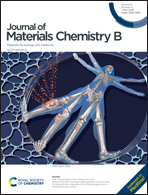Molecular simulations and understanding of antifouling zwitterionic polymer brushes†
Abstract
Zwitterionic materials are an important class of antifouling biomaterials for various applications. Despite such desirable antifouling properties, molecular-level understanding of the structure–property relationship associated with surface chemistry/topology/hydration and antifouling performance still remains to be elucidated. In this work, we computationally studied the packing structure, surface hydration, and antifouling property of three zwitterionic polymer brushes of poly(carboxybetaine methacrylate) (pCBMA), poly(sulfobetaine methacrylate) (pSBMA), and poly((2-(methacryloyloxy)ethyl)phosporylcoline) (pMPC) brushes and a hydrophilic PEG brush using a combination of molecular mechanics (MM), Monte Carlo (MC), molecular dynamics (MD), and steered MD (SMD) simulations. We for the first time determined the optimal packing structures of all polymer brushes from a wide variety of unit cells and chain orientations in a complex energy landscape. Under the optimal packing structures, MD simulations were further conducted to study the structure, dynamics, and orientation of water molecules and protein adsorption on the four polymer brushes, while SMD simulations to study the surface resistance of the polymer brushes to a protein. The collective results consistently revealed that the three zwitterionic brushes exhibited stronger interactions with water molecules and higher surface resistance to a protein than the PEG brush. It was concluded that both the carbon space length between zwitterionic groups and the nature of the anionic groups have a distinct effect on the antifouling performance, leading to the following antifouling ranking of pCBMA > pMPC > pSBMA. This work hopefully provides some structural insights into the design of new antifouling materials beyond traditional PEG-based antifouling materials.



 Please wait while we load your content...
Please wait while we load your content...
